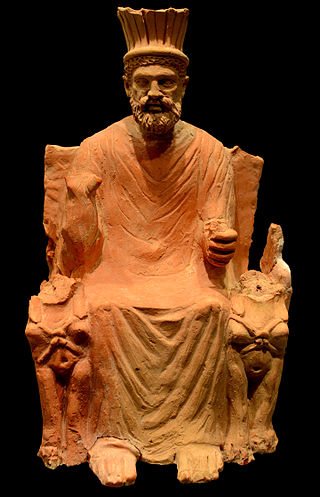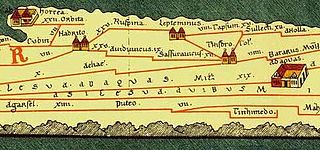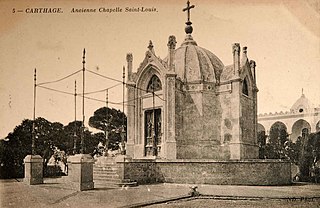
Byrsa was a walled citadel above the Phoenician harbour in ancient Carthage, Tunisia, as well as the name of the hill it rested on.

Byrsa was a walled citadel above the Phoenician harbour in ancient Carthage, Tunisia, as well as the name of the hill it rested on.
In Virgil's account of Dido's founding of Carthage, when Dido and her party were encamped at Byrsa, the local Berber chieftain offered them as much land as could be covered with a single oxhide. Therefore, Dido cut an oxhide into tiny strips and set them on the ground end to end until she had completely encircled the hilltop of Byrsa (Greek : βύρσα, "oxhide").
The citadel dominated the city below and formed the principal military installation of Carthage. Its name appeared on Carthaginian currency under the form 𐤁𐤀𐤓𐤏𐤕 (bʾrʿt). [1]
It was besieged by Scipio Aemilianus Africanus in the Third Punic War when the city was defeated and destroyed in 146 BCE. The Byrsa citadel was the seat of the proconsul of Africa within the Roman Empire. In 439 CE, Geiseric took possession of Carthage. The Vandal kings ruled North Africa from the Byrsa until the Byzantine emperor Justinian reconquered the province in 533.
St Louis Cathedral was built on Byrsa Hill starting in 1884, atop an ancient temple. Today, it serves as a cultural centre. [2] Byrsa Hill itself is part of the archaeological site of Carthage. In addition to a cathedral monument, the Carthage National Museum was erected atop it.
In 1994, the body of an ancient Carthaginian individual was excavated from a 2500-year-old Punic tomb in Byrsa Hill. In 2016, he was found to belong to the rare U5b2c1 maternal haplogroup. The Young Man of Byrsa specimen dates from the late 6th century BC, and his lineage is believed to represent early gene flow from Iberia to the Maghreb. [3]

Carthage was an ancient city on the eastern side of the Lake of Tunis in what is now Tunisia. Carthage was one of the most important trading hubs of the Ancient Mediterranean and one of the most affluent cities of the classical world. It became the capital city of the civilisation of Ancient Carthage and later Roman Carthage.

Dido, also known as Elissa, was the legendary founder and first queen of the Phoenician city-state of Carthage, in 814 BC. In most accounts, she was the queen of the Phoenician city-state of Tyre who fled tyranny to found her own city in northwest Africa. Known only through ancient Greek and Roman sources, all of which were written well after Carthage's founding, her historicity remains uncertain. The oldest references to Dido are attributed to Timaeus, who was active around 300 BC, or about five centuries after the date given for the foundation of Carthage.

Baal Hammon, properly Baʿal Ḥamon, meaning "Lord Hammon", was the chief god of Carthage. He was a weather god considered responsible for the fertility of vegetation and esteemed as King of the Gods. He was depicted as a bearded older man with curling ram's horns. Baʿal Ḥammon's female cult partner was Tanit.
In the Hebrew Bible, Tophet or Topheth is a location in Jerusalem in the Valley of Hinnom (Gehenna), where worshipers engaged in a ritual involving "passing a child through the fire", most likely child sacrifice. Traditionally, the sacrifices have been ascribed to a god named Moloch. The Bible condemns and forbids these sacrifices, and the tophet is eventually destroyed by king Josiah, although mentions by the prophets Jeremiah, Ezekiel, and Isaiah suggest that the practices associated with the tophet may have persisted.

Tanit or Tinnit was a Carthaginian Punic goddess, and the chief deity of Ancient Carthage, alongside her consort Baal Hammon.

Utica was an ancient Phoenician and Carthaginian city located near the outflow of the Medjerda River into the Mediterranean, between Carthage in the south and Hippo Diarrhytus in the north. It is traditionally considered to be the first colony to have been founded by the Phoenicians in North Africa. After Carthage's loss to Rome in the Punic Wars, Utica was an important Roman colony for seven centuries.

Hadrumetum, also known by many variant spellings and names, was a Phoenician colony that pre-dated Carthage. It subsequently became one of the most important cities in Roman Africa before Vandal and Umayyad conquerors left it ruined. In the early modern period, it was the village of Hammeim, now part of Sousse, Tunisia.

Motya was an ancient and powerful city on San Pantaleo Island off the west coast of Sicily, in the Stagnone Lagoon between Drepanum and Lilybaeum. It is within the present-day commune of Marsala, Italy.

The Punic religion, Carthaginian religion, or Western Phoenician religion in the western Mediterranean was a direct continuation of the Phoenician variety of the polytheistic ancient Canaanite religion. However, significant local differences developed over the centuries following the foundation of Carthage and other Punic communities elsewhere in North Africa, southern Spain, Sardinia, western Sicily, and Malta from the ninth century BC onward. After the conquest of these regions by the Roman Republic in the third and second centuries BC, Punic religious practices continued, surviving until the fourth century AD in some cases. As with most cultures of the ancient Mediterranean, Punic religion suffused their society and there was no stark distinction between religious and secular spheres. Sources on Punic religion are poor. There are no surviving literary sources and Punic religion is primarily reconstructed from inscriptions and archaeological evidence. An important sacred space in Punic religion appears to have been the large open air sanctuaries known as tophets in modern scholarship, in which urns containing the cremated bones of infants and animals were buried. There is a long-running scholarly debate about whether child sacrifice occurred at these locations, as suggested by Greco-Roman and biblical sources.

The Punic people, usually known as the Carthaginians, were a Semitic people who migrated from Phoenicia to the Western Mediterranean during the Early Iron Age. In modern scholarship, the term Punic, the Latin equivalent of the Greek-derived term Phoenician, is exclusively used to refer to Phoenicians in the western Mediterranean, following the line of the Greek East and Latin West. The largest Punic settlement was Ancient Carthage, but there were 300 other settlements along the North African coast from Leptis Magna in modern Libya to Mogador in southern Morocco, as well as western Sicily, southern Sardinia, the southern and eastern coasts of the Iberian Peninsula, Malta, and Ibiza. Their language, Punic, was a dialect of Phoenician, one of the Northwest Semitic languages originating in the Levant.

Leptis or Lepcis Parva was a Phoenician colony and Carthaginian and Roman port on Africa's Mediterranean coast, corresponding to the modern town Lemta, just south of Monastir, Tunisia. In antiquity, it was one of the wealthiest cities in the region.

The Acropolium, also known as Saint Louis Cathedral, is a former Roman Catholic church located in Carthage, Tunisia.

The city of Carthage was founded in the 9th century BC on the coast of Northwest Africa, in what is now Tunisia, as one of a number of Phoenician settlements in the western Mediterranean created to facilitate trade from the city of Tyre on the coast of what is now Lebanon. The name of both the city and the wider republic that grew out of it, Carthage developed into a significant trading empire throughout the Mediterranean. The date from which Carthage can be counted as an independent power cannot exactly be determined, and probably nothing distinguished Carthage from the other Phoenician colonies in Northwest Africa and the Mediterranean during 800–700 BC. By the end of the 7th century BC, Carthage was becoming one of the leading commercial centres of the West Mediterranean region. After a long conflict with the emerging Roman Republic, known as the Punic Wars, Rome finally destroyed Carthage in 146 BC. A Roman Carthage was established on the ruins of the first. Roman Carthage was eventually destroyed—its walls torn down, its water supply cut off, and its harbours made unusable—following its conquest by Arab invaders at the close of the 7th century. It was replaced by Tunis as the major regional centre, which has spread to include the ancient site of Carthage in a modern suburb.

Ancient Carthage was an ancient Semitic civilisation based in North Africa. Initially a settlement in present-day Tunisia, it later became a city-state and then an empire. Founded by the Phoenicians in the ninth century BC, Carthage reached its height in the fourth century BC as one of the largest metropolises in the world. It was the centre of the Carthaginian Empire, a major power led by the Punic people who dominated the ancient western and central Mediterranean Sea. Following the Punic Wars, Carthage was destroyed by the Romans in 146 BC, who later rebuilt the city lavishly.

Carthage National Museum is a national museum in Byrsa, Tunisia. Along with the Bardo National Museum, it is one of the two main local archaeological museums in the region. The edifice sits atop Byrsa Hill, in the heart of the city of Carthage. Founded in 1875, it houses many archaeological items from the Punic era and other periods.
In several ancient Semitic-speaking cultures and associated historical regions, the shopheṭ or shofeṭ was a community leader of significant civic stature, often functioning as a chief magistrate with authority roughly equivalent to Roman consular powers.

The Chapelle Saint-Louis de Carthage was a Roman Catholic church located in Carthage, Tunisia. It was built between 1840 and 1841 on land donated by the Bey of Tunis to the King of France in 1830. The chapel was located atop Byrsa Hill, at the heart of the Archaeological Site of Carthage, until it was destroyed in 1950.
Carthaginian or Punic currency refers to the coins of ancient Carthage, a Phoenician city-state located near present-day Tunis, Tunisia. Between the late fifth century BC and its destruction in 146 BC, Carthage produced a wide range of coinage in gold, electrum, silver, billon, and bronze. The base denomination was the shekel, probably pronounced in Punic. Only a minority of Carthaginian coinage was produced or used in North Africa. Instead, the majority derive from Carthage's holdings in Sardinia and western Sicily.
Thenae or Thenai, also written Thaena and Thaenae, was a Carthaginian and Roman town located in or near Thyna, now a suburb of Sfax on the Mediterranean coast of southeastern Tunisia.

Ounga, also known as Younga and Jounga, is an archaeological site on the Mediterranean coast of Tunisia, located 45 km (28 mi) south of Sfax along the Mediterranean coast. The area is also known for its oil fields.
36°51′08″N10°19′26″E / 36.85222°N 10.32389°E